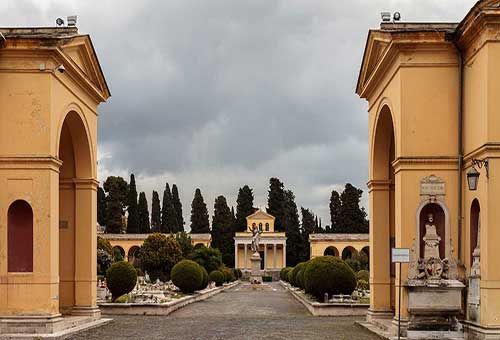The Verano (officially the “Communal Monumental Cemetery of Campo Verano”) is located in the quartiere Tiburtino of Rome, near the Basilica of San Lorenzo fuori le mura. The name verano refers to the Ancient Roman campo dei Verani that was located here.
The zone contained ancient Christian catacombs. A modern cemetery was not established until the Napoleonic Kingdom of Italy during 1807–1812, when the architect Giuseppe Valadier was commissioned for designs after the Edict of Saint Cloud required burials to take place outside of the city walls.
Works began in 1811 in the selected area, close to the Basilica of San Lorenzo Fuori le Mura [outside the city wall], a plot that originally belonged to the Verani family. In 1859 new works began, on the basis of a plan by Virginio Vespignani. Overall, the aspect of the Cemetery is typified by the original XIX century structure by Vespignani (gateway, Quadriportico and Chapel), that are matched, in terms of architectural and urban quality, by the remarkable structures of the Pincetto vecchio and the Pincetto nuovo, with especially valuable items from the last decades of the XIX century onwards.
The cemetery hosts several works by major Roman and Italian architects and sculptors. To mention but a few authors: G. Koch, Pio and Marcello Piacentini, G. Monteverde, E. Ximenes, P. Canonica, E. Ferrari, D. Cambellotti. The series of XIX century funerary portraits by Filippo Severati are especially interesting, due to the originality of materials and their inherent quality: they are painted on lava and represent an important gallery of the affluent Roman bourgeoisie, who, as clients, required artefacts up to their role.





